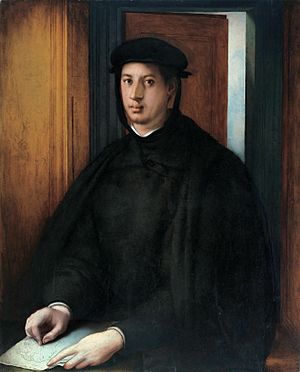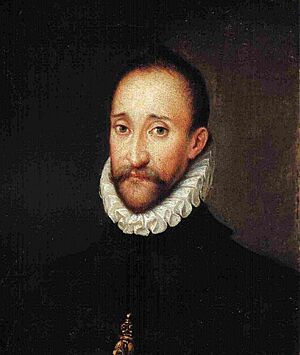Margaret of Parma facts for kids
Quick facts for kids Margaret |
|
|---|---|

Portrait by Antonio Moro, circa 1562
|
|
| Duchess consort of Florence | |
| Tenure | 18 January 1536 – 6 January 1537 |
| Duchess consort of Parma and Piacenza | |
| Tenure | 10 September 1547 – 18 January 1586 |
| Born | 5 July 1522 Oudenaarde, Burgundian Low Countries |
| Died | 18 January 1586 (aged 63) Ortona, Kingdom of Naples |
| Burial | San Sisto, Piacenza |
| Spouse |
Alessandro de' Medici, Duke of Florence
(m. 1536; died 1537)Ottavio Farnese, Duke of Parma
(m. 1538) |
| Issue | Charles Farnese Alexander Farnese, Duke of Parma |
| House | Habsburg |
| Father | Charles V, Holy Roman Emperor |
| Mother | Johanna Maria van der Gheynst |
| Signature | |
Margaret of Parma (born July 5, 1522 – died January 18, 1586) was an important ruler in the 16th century. She was the Governor of the Netherlands from 1559 to 1567, and again from 1578 to 1582. Margaret was the daughter of Holy Roman Emperor Charles V. Her mother was Johanna Maria van der Gheynst. Through her marriages, Margaret also became a Duchess of Florence and a Duchess of Parma and Piacenza in Italy.
Contents
Early Life and Education
Margaret's mother, Johanna Maria van der Gheynst, was from Flanders. Margaret grew up in Mechelen, a city in what is now Belgium. She was raised by her great-aunt, Archduchess Margaret of Austria, and later by her aunt, Mary of Austria. Both of these women were governors of the Netherlands before Margaret.
Her father, Emperor Charles V, had big plans for Margaret. He used her to help strengthen his empire.
Life in Italy
In 1527, when Margaret was five, she was engaged to Alessandro de' Medici, Duke of Florence. He was the nephew of Pope Clement VII. This marriage was planned to help her father gain more power in Italy. The agreement was signed in 1529.
In 1533, at age 11, Margaret moved to Italy. She lived and was educated in important courts in Florence, Rome, and Parma. She learned many skills that helped her become a strong and independent woman. Margaret loved Italian culture and preferred to speak Italian for the rest of her life.
Marriages and Family
Margaret married Alessandro de' Medici on June 13, 1536, in Florence. However, Alessandro was killed on January 6, 1537, making Margaret a widow at a young age.
On November 4, 1538, she married Ottavio Farnese, Duke of Parma, in Rome. Margaret was 15, and Ottavio was 14. She did not want to marry him at first. Even though their marriage was not very happy, it gave her many years of experience in Rome.
Children
Margaret and Ottavio had twin sons. One of them died when he was a baby. The other son was Alexander Farnese, Duke of Parma. Margaret continued to study art and politics during her marriage to Ottavio. She often lived separately from him and had her own court.
Governor of the Netherlands
In 1555, Margaret left Italy and went to the Netherlands. Her half-brother, Philip II, appointed her as Governor of the Netherlands in 1559. This was a very challenging job.
Facing Challenges
As governor, Margaret faced growing unhappiness in the Netherlands. People were upset about the Inquisition, which was a religious court, and about Spain's strict rule. Philip II gave Margaret little real power. He wanted to rule in his own way, which led to a big revolt in the Netherlands.
Margaret had to listen to Cardinal Granvelle, Philip's main advisor. Granvelle became very unpopular. After he was sent away in 1564, Margaret had to rely on local nobles for advice.
The Revolt
In 1565, some Dutch nobles formed an opposition group. Margaret listened to their complaints and promised to stop the religious repression. In 1566, there were riots where people destroyed religious images across the Netherlands. Margaret managed to stop these riots with the help of local leaders.
The next year, Philip II sent military help led by the Duke of Alba. Margaret warned Philip that Alba's actions would cause disaster. However, Philip gave Alba more power than her. Margaret resigned in 1567 because her authority was taken away.
Later Life and Death
After resigning, Margaret moved to L'Aquila in Italy. She became Governor of Abruzzo and Viceroy of Naples. She also advised her son, Alexander Farnese, and her half-brother, John of Austria.
In 1578, her son Alexander Farnese became governor-general of the Netherlands. Philip II made Margaret his co-ruler, hoping they would work together. But they could not agree, so Margaret retired to Namur in 1582. Philip allowed her to return to Italy in 1583.
Margaret died in Ortona in 1586. She was buried in the church of S. Sisto in Piacenza.
Issue
Margaret and her second husband, Ottavio Farnese, Duke of Parma, had two sons:
- Charles Farnese (born and died in 1545), who was meant to inherit the Duchy of Parma.
- Alexander Farnese, Duke of Parma (born 1545 – died 1592), who became the 3rd Duke of Parma. He married Infanta Maria of Portugal and had children.
Coat of Arms
Margaret of Austria, as Duchess of Florence and Parma, chose a pearl shining from its shell as her symbol. Her motto was Decus allatura coronae, which means "About to bring glory to the crown."
See also
 In Spanish: Margarita de Parma para niños
In Spanish: Margarita de Parma para niños



